By Jesse Badger, Spoke and Bird, guest contributor
Spoke and Bird is a café-style restaurant that opened last year (2015) in Chicago’s South Loop — a neighborhood near downtown that, over the past couple of decades, has rebounded from a period of economic decline.
Alicia Bird and Scott Golas are the couple who gave up their past careers in digital advertising to start the restaurant across the street from their residence, and they also opened Spoke and Bird Bakehouse two miles due west in the Pilsen neighborhood. “Bird” refers to the co-owner’s last name; “Spoke” stems from the fact that both are avid cyclists.
As they were planning the restaurant, Bird and Golas determined they would source ingredients as locally as possible. They also hired Jesse Badger — who formerly worked in the kitchens of highly regarded Chicago restaurants such as Ombra, Dusek’s and Chef Stephanie Izard’s Little Goat Diner — as their executive chef.
In this latest installment of Good Food on Every Table’s “Farm to Table: Keeping It Real” series, Badger explains how Spoke and Bird addresses the challenges faced by small restaurants in developing relationships with their farmers for meat and produce purchases. Among the approaches they use is taking organ meats off the hands of producers who otherwise have a hard time selling them — a practice that, as you’ll read, benefits both their two-legged customers and their customers’ four-legged friends, and reduces food waste.
And Badger presents how these relationships also lend themselves to their produce-based dishes, including the complicated evolution of “Beans & Cornbread,” one of Spoke and Bird’s signature dishes, which sounds simple but was anything but.

Using a whole animal is always one of the most difficult things for a restaurant of our size to try and figure out. So as we’ve developed relationships with farmers, we’ve adapted a more nuanced take on how to go about maximizing the yield from any given carcass.
Instead of purchasing an entire animal and trying to use the whole thing ourselves, we just talk to our farmers (and sometimes even a responsible and sustainable supplier such as Local Foods) and see what they happen to have in surplus at a given time. We then try and figure out ways to use those products.
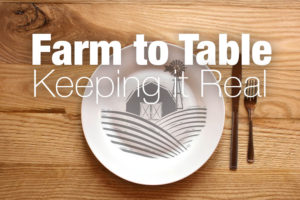 And, as time has gone by, this approach has expanded from the proteins to our produce-only farm partners as well.
And, as time has gone by, this approach has expanded from the proteins to our produce-only farm partners as well.
As a restaurant that believes strongly in utilizing whole animals, we have always wanted to use more of the organ meats and offal that Trent Sparrow from Catalpa Grove Farm (in Dwight in east-central Illinois) has trouble getting rid of most weeks. This is an interesting conundrum from a whole animal standpoint, because when you get an entire carcass you get one heart, one liver, two kidneys and two lungs. This isn’t really enough to make many portions out of for a decently busy restaurant, unless you combine it all in some sort of farce or a dish like Lamb Lights (basically all the offal from a carcass in one stew).
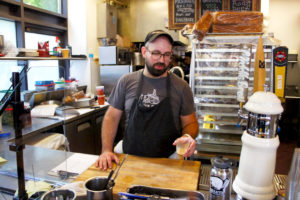
Chef Jesse Badger brought a dedication to using whole animals and produce to Spoke and Bird when it opened in 2015.
Moreover, when most places order a “whole” pig, they don’t take the offal. They just get the hanging carcass, which is comprised of the lean and braising cuts but none of the organs (other than the brain and eyes which, due to their location, would be more trouble to remove than they are worth and are therefore factored into the per pound cost of a carcass as waste).
This means that for every entire hog sold either as-is or parted out to restaurants as loins and shoulders, our farmer is left holding the bag, which in this case happens to be filled with the unmarketable organs of several pigs or lambs. Most of the time, they just end up in the trash because there is nowhere else for them to reasonably go.
When we asked Trent, he said he always had a surplus of pork livers and hearts and all the lamb organs we could ever want. It just so happened we were planning on making our breakfast sausage in-house at the time this came up, so we bought everything he could get for us, rinsed it in changes of clean water for an entire week to get rid of some of the funky iron-ish flavor, then ground it into our all-pork sausage mix, seasoned it, cased it, poached it in a mixture of beer, pork stock and whiskey, and put it on the menu.

Chicago’s downtown skyline is within eyeshot of Spoke and Bird, a casual restaurant with high farm to table values that is located in the South Loop neighborhood.
Most of our guests can’t put their finger on what exactly gives it the extra depth of flavor, but it is consistently one of the things on which we get the nicest compliments, all from something partially motivated by a desire to utilize a throwaway cut.
The lamb organs required a little more creativity. We wanted to maintain our breakfast sausage as 100 percent pork and didn’t have any easy ground lamb product to disguise all the livers, hearts, kidneys and sweetbreads in — not too mention the fact that Trent had way more than we could have ever utilized in this way each week anyway. Fortunately for us, the neighborhood where we are located is extremely dog-friendly, including our patio, and we were trying to think of something to make in-house specifically for all our canine guests.
We came across a recipe in, of all places, the Bouchon Bakery cookbook that used foie gras scrap and chicken livers to make dog treats, and we figured there was no reason we couldn’t adapt that to lamb organs. We made a test batch and they were widely popular with the target audience, although slightly less so with the food runner who tasted one thinking it was a new kind of cookie we were trying out.
Both of these applications allow us to help our farmer generate more revenue from the same number of carcasses. At the same time, we can offer something unique and with increased flavor and nutritional content to our guests (and their pets) and generate a little extra revenue ourselves. (And for the sake of transparency, the sweetbreads almost never end up in the dog biscuits. They usually get brined, poached, cleaned, breaded and fried and eaten as a snack by me and whoever else happens to be lucky enough to be standing around when I make them.)
Long-Distance Cycling to Beans & Cornbread
The analogous version of this from the vegetable portion of our menu can vary a lot from one instance to the next. A good example is something that has become one of the dishes we are most proud of, and something we consider a signature of our personal style. As it is described on the menu, it is simply “Beans & Cornbread,” but its actual composition and conception were considerably more complicated.
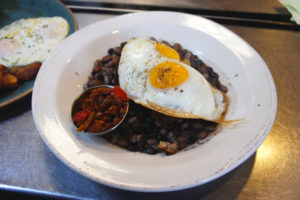
The beans in the Beans and Cornbread, a signature item on Spoke and Bird’s menu, are often served with a fried egg on top. The cornbread muffin (right) is made with huitlachoche, a corn fungus that has long been used in Mexican cooking and has gained acceptance in the U.S. as a delicacy in recent years.
First, we had been experimenting with a savory cornbread muffin to make as a somewhat unique breakfast pastry. We were already using cornmeal from Three Sisters Garden (in Kankakee, Illinois) for it, but since there was no sweet corn available at the time, we had difficulty finding a way to introduce some textural variation and depth of flavor.
It just so happened that Tracey Vowell, one of Three Sisters’ owners, had a lot of huitlacoche, a corn fungus (also known as corn smut or corn truffle), which is considered a delicacy in traditional Mexican cuisine. Three Sisters harvests it in season then Individually Quick Freezes (IQF) it so they can sell it throughout the year as clients call for it. So we started buying it and folding it into the muffin batter to achieve little pops of that rich “corn truffle” flavor.
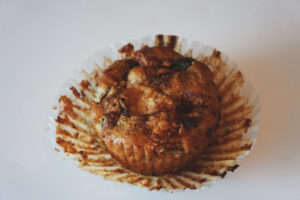 Then, after the end of summer when fresh produce available locally started to drop off, we were trying to find something local we could use year-round and hopefully still be purchasing from Three Sisters to help support them through the winter. It just so happens they also grow and dry really nice varieties of beans.
Then, after the end of summer when fresh produce available locally started to drop off, we were trying to find something local we could use year-round and hopefully still be purchasing from Three Sisters to help support them through the winter. It just so happens they also grow and dry really nice varieties of beans.
We tried a couple of Mediterranean specials with some lamb T-bones Catalpa Grove had gotten stuck with when someone special ordered them then refused to take delivery. We also used verjus (acidic juice from unripened grapes) from Capshew Cellars in Floyds Knobs, Indiana, whom I had started buying from when I lived and worked in Louisville, Kentucky. I have continued purchasing from him since I moved north because there just isn’t really anyone else making small batch artisanal vinegars like he does (although paying to ship them here UPS is a bit of a pain).
Those were good dishes, but the pickups were a little overcomplicated for how busy we were at the time, and they also just didn’t really feel like our food. Then one day we had the idea to combine the Huitlacoche Corn Muffins we were selling as pastries with the beans we were making for the lamb special. The outcome was a version of a dish I had eaten a lot growing up: mom’s homemade cornbread and stewed pinto beans. We added a couple of sunny-side-up farm eggs to make it feel more like a complete meal and less of an elaborate side… but it still didn’t come together entirely as a composed dish.

Spoke and Bird’s spacious patio provides a shady retreat in a heavily developed Chicago neighborhood.
What it was lacking was a little hit of spice and acidity to bring it all together. The solution came from an unintentional overabundance of garlic scapes, the green stalks that taste like the garlic bulb from which they grow. John Bailey, from whom we source all our honey and garlic, had approached me about maybe buying his garlic scapes. John and I had actually met at the Pilsen Community Market years before, when I was buying honey and garlic from him for personal use, and he had learned I had an interest in less common vegetable ingredients and worked in the restaurant industry.
At the time he wasn’t selling to any other restaurants, and the farmers markets he was frequenting didn’t have much demand for scapes, as they were looking for primarily mainstream produce. Which is how we somewhat foolishly came to agree to buy all the garlic scapes he could supply without first asking exactly how many that would be.
John showed up several days in a row that spring with about 50 pounds of garlic scapes each day. The only thing we could think to do with all of them to use them up before they went bad was to naturally ferment them into kimchi and stash them in a cool, dark place as we slowly whittled away at their 200-pound mass one special at a time. It wasn’t until about six months later when this kimchi presented itself as the ideal way to provide that spice and acidity to our “Beans & Cornbread,” which has since become a signature of the restaurant.*
The dish turned out to be a natural evolution of something culled together from relationships with our farmers and a desire to use as much of everything available to us as possible. It is an almost perfect example of the kind of synthesis and development that is only possible when you’re not just ordering from a producer, but actually reacting to what they have to offer, and working together to try and utilize as much of everything in the best way you possibly can.
* For full transparency, we have since switched the cornmeal to Brian Severson’s stone-milled fine yellow, but we still use Three Sisters for the huitlacoche and the beans.
Photographs by Bob Benenson/FamilyFarmed
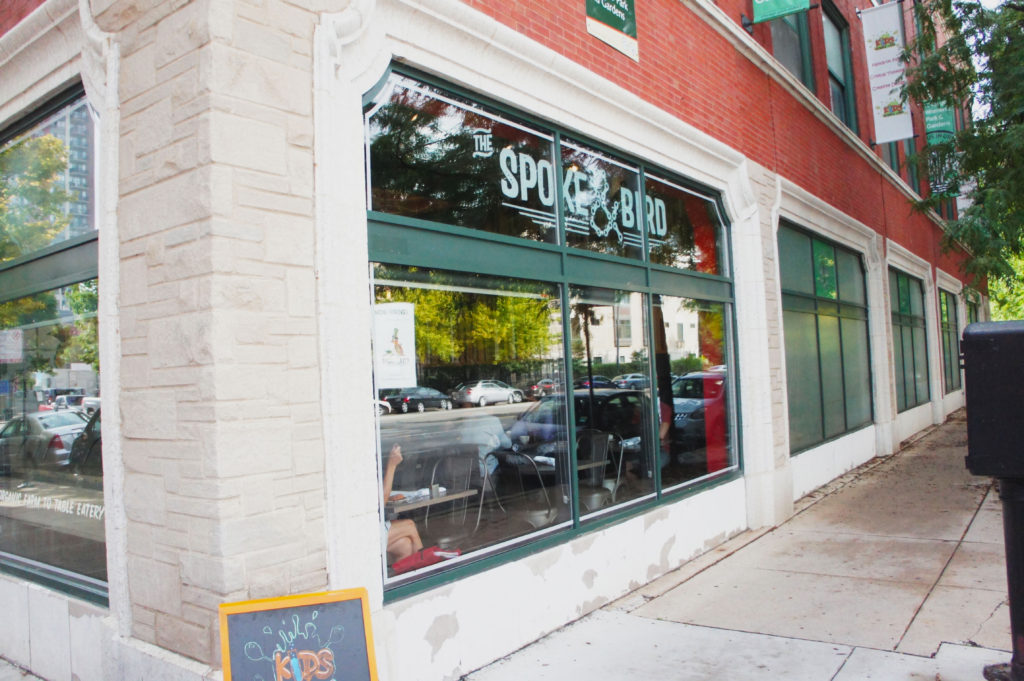
Spoke and Bird occupies a corner space at the intersection of 18th Street and Indiana Avenue in Chicago’s South Loop neighborhood.
